Biology
1/742
Name | Mastery | Learn | Test | Matching | Spaced |
|---|
No study sessions yet.
743 Terms
Cell Theory
All living things are composed of cells
The cell is the basic functional unit of life
Cells arise only from preexisting cells
Nucleolus
Where the ribosomal RNA (rRNA) is synthesized
Mitochondria
Two layers:
Outer Membrane: Barrier
Inner Membrane: Arranged into numerous infoldings called cristae, contains the molecules and enzymes of the ETC
Inter-Membrane Space: The space between the inner and outer membranes
Matrix: The space inside the inner membrane
Contain some of their own genes are replicate independently of the nucleus via binary fission
Cytoplasmic (Extranuclear) Inheritance
Transmission of genetic material independent of the nucleus
Lysosomes
Membrane-bound structures containing hydrolytic enzymes that are capable of breaking down many different substrates; Cause apoptosis by releasing their hydrolytic enzymes; Surrounded by a single membrane
Endosomes
Transport, package, and sort cell material traveling to and from the membrane
Endoplasmic Reticulum (ER)
Series of interconnected membranes that are actually contiguous with the nuclear envelope
Rough ER
Studded with ribosomes, which permit the translation of proteins destined for secretion directly into its lumen
Smooth ER
Lacks ribosomes and is utilized primarily for lipid synthesis and the detoxification of certain drugs and poisons; Transports proteins from the RER to the Golgi apparatus
Golgi Apparatus
Consists of stacked membrane-bound sacs; Receives materials from the ER via vesicles, these cellular products may be modified through the introduction of signal sequences, which direct the delivery of the product to a specific cellular location; Cellular products are repackaged in vesicles, which are then directed to the correct cellular location
Peroxisomes
Contain hydrogen peroxide, which breaks down very long chain fatty acids via beta-oxidation; Synthesis of phospholipids
Cytoskeleton
Provides structure to the cell and helps it to maintain its shape; Microfilaments, microtubules, and intermediate filaments
Microfilaments
Made up on solid polymerized rods of actin that provide protection for the cell; Use ATP to generate force for movement by interacting with myosin, such as in muscle contraction; Play a role in cytokinesis: during mitosis, the cleavage furrow is formed from _______, which organize as a ring at the site of division between the two new daughter cells. As the actin filaments within this ring contract, the ring becomes smaller, eventually pinching off the connection between the two daughter cells
Microtubules
Hollow polymers of tubulin proteins; Provide the primary pathways along which motor proteins like kinesin and dynein carry vesicles
Cilia: Projections from a cell that are primarily involved in the movement of materials along the surface of the cell
Flagella: Structures involved in the movement of the cell itself
9 + 2 Structure
Cilia and flagella share the same structure, composed of nine pairs of microtubules forming an outer ring, with two microtubules in the center
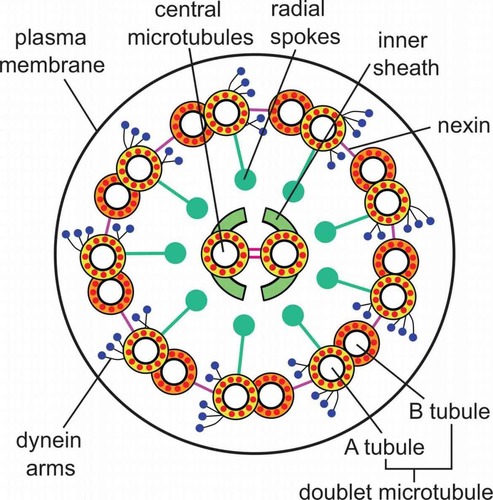
Centrioles
Found in the centrosome; During mitosis, these organelles migrate to opposite poles of the dividing cell and organize the mitotic spindle. The microtubules emanating from the ______ attach to the chromosomes via complexes called kinetochores and exert force on the sister chromatids, pulling them apart.
Intermediate Filaments
Filamentous proteins involved in cell-cell adhesion or maintenance of the overall integrity of the cytoskeleton; Anchor other organelles
Epithelial Tissues
Cover the body and line its cavities, providing a means for protection against pathogen invasion and desiccation; To remain as one cohesive unit, these cells are tightly joined to each other and to an underlying layer of connective tissue known as the basement membrane; Constitute the parenchyma, or the functional parts of the organ
Simple Epithelia
Epithelial tissues with one layer of cells
Stratified Epithelia
Epithelial tissues with multiple layers
Pseudostratified Epithelia
Epithelial tissues that appear to have multiple layers due to differences in cell height but are, in reality, only one layer
Cuboidal Cells
Type of epithelial cells that are cube-shaped
Columnar Cells
Type of epithelial cells that are long and thin
Squamous Cells
Type of epithelial cells that are flat and scale-like
Connective Tissue
Supports the body and provides a framework for the epithelial cells to carry out their functions; Main contributors to the stroma or support structure; Bone, cartilage, tendons, ligaments, adipose tissue, blood
Archaea
Single-celled organisms that are visually similar to bacteria but contain genes and several metabolic pathways that are more similar to eukaryotes than to bacteria
Extremophiles
Type of archaea that are commonly isolated from harsh environments with extremely high temperatures, high salinity, or no light
Mutualistic Symbiotes
Both species benefit from the relationship
Pathogens (Parasites)
When a species provides no advantage or benefit to the host, but rather cause disease
Cocci
Spherical bacteria; I.e. Streptococcus pyogenes
Bacilli
Rod-shapes bacteria; I.e. E. coli
Spirilli
Spiral-shaped bacteria
Obligate Aerobes
Bacteria that require oxygen for metabolism
Anaerobes
Bacteria that use fermentation, or some other form of cellular metabolism that does not require oxygen
Obligate Anaerobes
Anaerobes that cannot survive in an oxygen-containing environment; The presence of oxygen leads to the production of reactive oxygen-containing radicals in these species, which leads to cell death
Facultative Anaerobes
Anaerobes that can toggle between metabolic processes, using oxygen for aerobic metabolism if it is present, and switching to anaerobic metabolism if not
Aerotolerant Anaerobes
Anaerobes that are unable to use oxygen for metabolism, but are not harmed by its presence in the environment
Cell Wall
Forms the outer barrier of the cell in prokaryotes; Provides structure and controls the movement of solutes into and out of the bacterium
Two Types:
Gram Positive: Deep purple when stained; Peptidoglycan and lipoteichoic acid
Gram Negative: Pink-red when stained
Envelope
The cell wall and cell membrane (composed of phospholipids) in prokaryotes
Peptidoglycan
A polymeric substance made from amino acids and sugars in gram-positive cell walls; Found in smaller amounts in gram-negative cell walls
Gram-Positive Cell Walls
Deep purple when stained; Peptidoglycan and lipoteichoic acid
Gram-Negative Cell Walls
Very thin and also contain peptidoglycan, but in much smaller amounts; Periplasmic space separate peptidoglycan cell walls from the cell membrane; Outer membranes contain phospholipids and lipopolysaccharides; Pink-red when stained
Flagella
Long, whip-like structures that can be used for propulsion; bacteria may have 1+; Can be used to move toward food or away from toxins or immune cells; Composed of a filament, a basal body, and a hook
Filament: A hollow, helical structure composed of flagellin
Basal Body: Complex structure that anchors the flagellum to the cytoplasmic membrane and is also a motor of the flagellum
Hook: Connects the filament and the basal body so that, as the basal body rotates, it exerts torque on the filament, which thereby spins and propels the bacterium forward
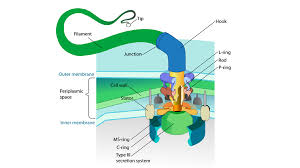
Chemotaxis
The ability of a cell to detect chemical stimuli and move toward or away from them
Binary Fission
A simple form of asexual reproduction seen in prokaryotes; The circular chromosome attaches to the cell wall and replicates while the cell continues to grow in size. Eventually, the plasma membrane and the cell wall begin to grow inward along the midline of the cell to produce two identical daughter cells.; Faster than mitosis
Plasmids
Carry genes that impart some benefit to the bacterium, such as antibiotic resistance; Carry virulence factors
Virulence Factors
Traits that increase pathogenicity, such as toxin production, projections that allow attachment to certain kinds of cells, or features that allow evasion of the host’s immune system
Episomes
Type of plasmid that is capable of integrating into the genome of the bacterium
Transformation
Results from the integration of foreign genetic material (often from other bacteria) into the host genome
Conjugation
The bacterial form of mating (sexual reproduction)
Two cells form a conjugation bridge between them that facilitates the transfer of genetic material. The transfer is unidirectional, from the donor male (+) to the recipient female (-). The bridge is made from appendages called sex pili that are found on the donor male. To form the pilus, bacteria must contain plasmids known as sex factors that contain the necessary genes.
F (Fertility Factor)
Sex factor in E. coli (F+); During conjugation the F+ cell replicates its F factor and donates the copy to the F- cell, converting it to an F+ cell
High Frequency of Recombination (Hfr)
Bacteria that have conjugative plasmid integrated into their chromosomal DNA
Transduction
Transfer of genetic material from one bacterium to another via a bacteriophage vector
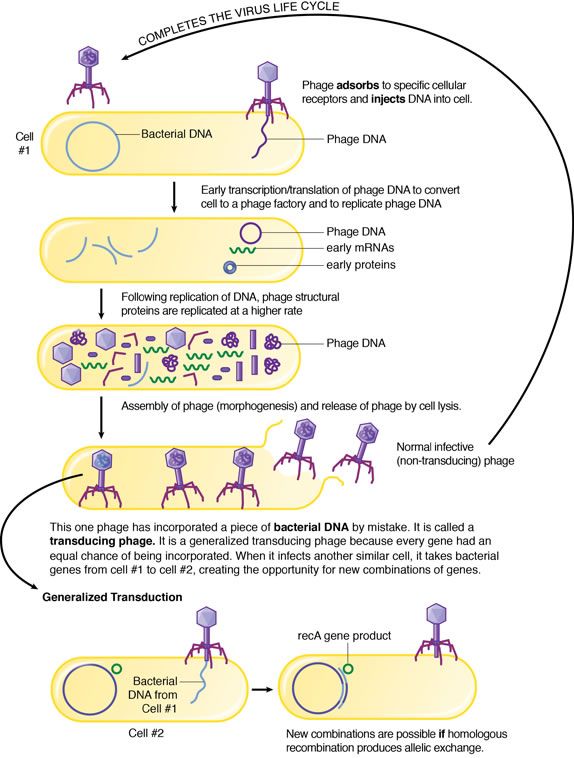
Bacteriophages
Viruses that infect bacteria; Do not enter bacteria but instead inject their genetic material, leaving the remaining structures outside the infected cell; Contain a capsid, a tail sheath, and tail fibers
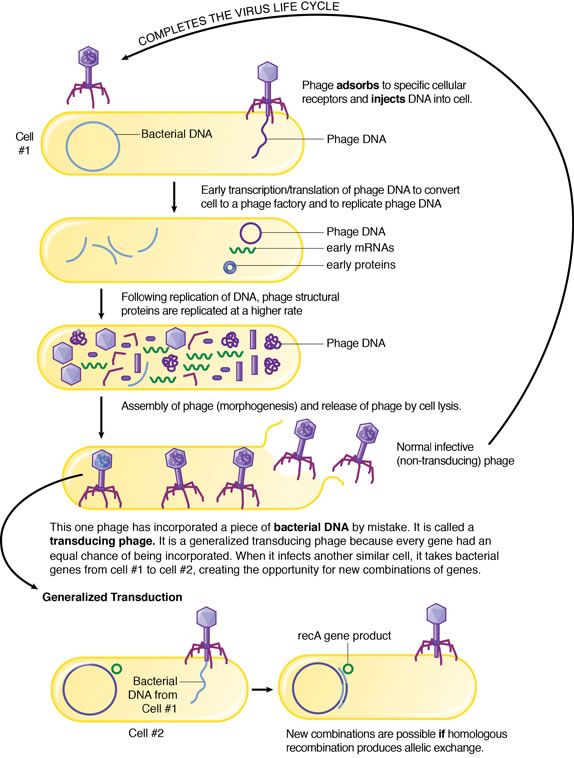
Transposons
Genetic elements capable of inserting and removing themselves from the genome
Bacterial Growth
Lag Phase: The bacteria adapt to new local conditions
Exponential (Log) Phase: Growth then increases exponentially
Stationary Phase: As resources are reduced, growth levels off
Death Phase: As resources are depleted, bacteria undergo a death phase
Capsid
The protein coat around viruses, which may be surrounded by an envelope composed of phospholipids and virus-specific proteins; Envelopes are very sensitive to heat and thus enveloped viruses are easier to kill
Host Cell
Viruses must express and replicate genetic information within this because they lack ribosomes to carry out protein synthesis
Virions
The viral progeny produced by viruses replicating in their host cells, which can be released to infect additional cells
Tail Sheath
Part of the bacteriophage that acts like a syringe, injecting genetic material into a bacterium
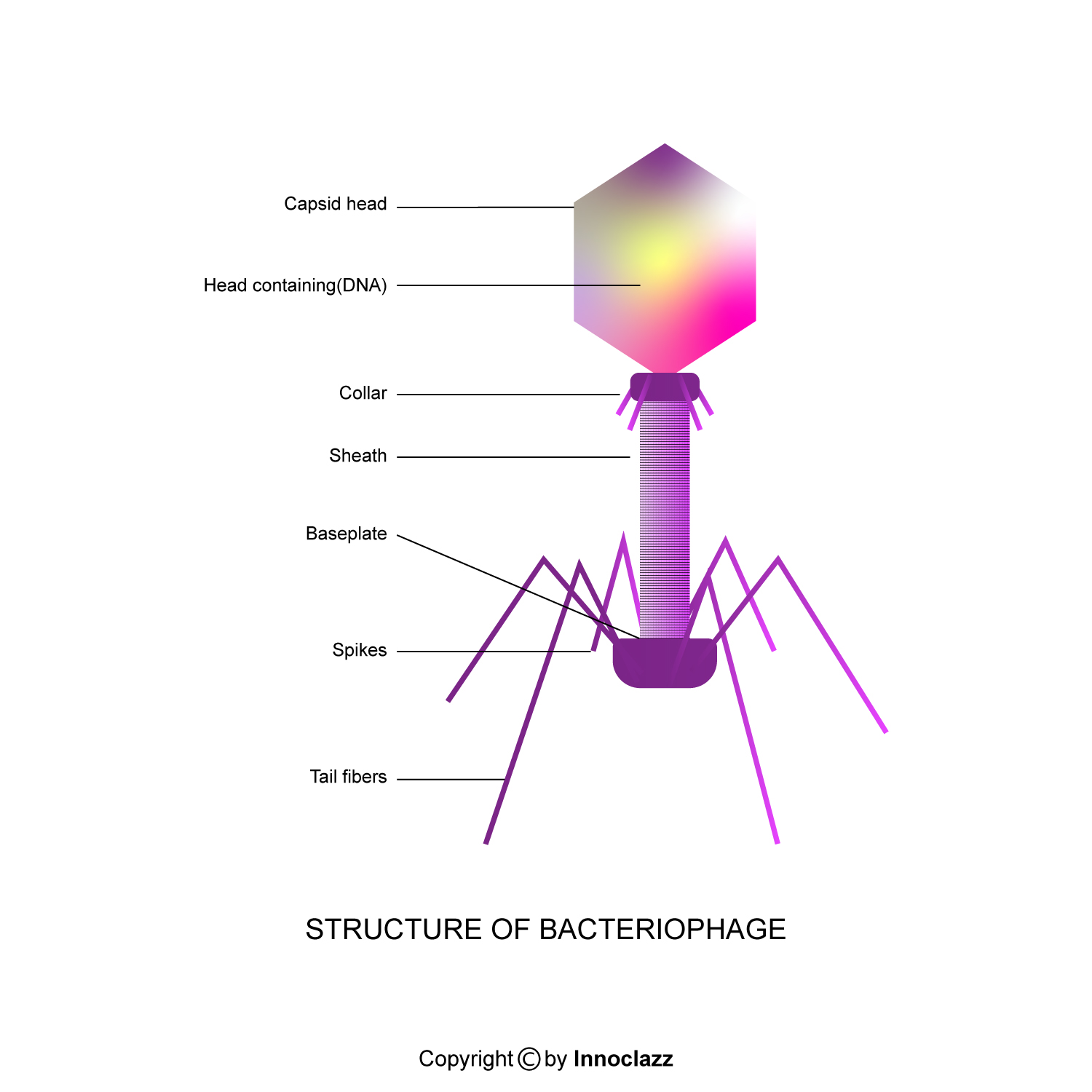
Tail Fibers
Part of the bacteriophage that help it recognize and connect to the correct host cell

Positive Sense
Type of single-stranded RNA virus that has a genome that may be directly translated to the functional proteins by the ribosomes of the host cell, just like mRNA
Negative Sense
Type of single-stranded RNA virus; The RNA strand acts as a template for synthesis of a complementary strand, which can then be used as a template for protein synthesis; Must carry an RNA replicase
RNA Replicase
Enzyme carried by negative-sense RNA viruses in the virion to ensure that the complementary strand is synthesized
Retroviruses
Enveloped, single-stranded RNA viruses in the family Retroviridae; Usually, the virion contains two identical RNA molecules. These viruses carry reverse transcriptase, which synthesizes DNA from single-stranded RNA. The DNA then integrates into the host cell genome, where it is replicated and transcribed as if it were the host cell’s own DNA.; The only way to remove the infection is to kill the infected cell; Ex. HIV
Extrusion
A method of progeny release for viruses; A virus leaves its host cell by fusing with the plasma membrane; This process keeps the host cell alive, and thus allows for the continued use of the host cell by the virus in a state called the productive cycle
Lytic Cycle
A bacteriophage maximizes the use of the cell’s machinery with little regard for the survival of the host cell. Once the host is swollen with new virions, the cell lyses, and other bacteria can be infected.; Viruses in this phase are termed virulent
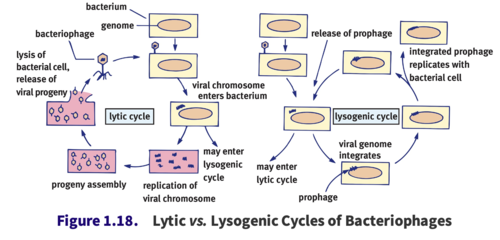
Lysogenic Cycle
Initiated when the virus does not lyse the bacterium and instead integrates into the host genome as a provirus or prophage; The virus will be replicated as the bacterium reproduces because it is now a part of the host’s genome.; Environmental factors may cause the provirus to leave the genome and revert to a lytic cycle
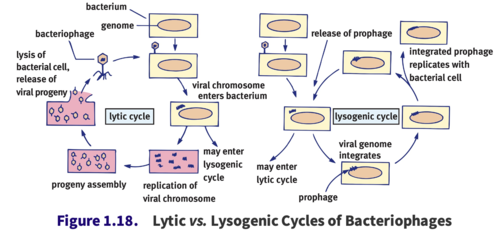
Superinfection
Simultaneous infection by multiple viruses; Bacteria are less susceptible to infection by one strain of phage when infected with another strain of phage
Prions
Infectious proteins and, therefore, nonliving; Cause disease by triggering misfolding of other proteins, usually through the conversion of a protein from an alpha-helical structure to a beta-pleated sheet → Reduces the solubility of a protein and the ability of the cell to degrade the protein
Viroids
Small pathogens consisting of a very short circular single-stranded RNA that infect plants; Bind to RNA sequences and silence genes in the plant genome → prevents synthesis of necessary proteins
Diploid
2n; Contain two copies of each chromosome
Haploid
n; Contain only one copy of each chromosome
G0 Stage
The cell is simply living and carrying out its functions, without any preparation for division
G1 Stage
Cells create organelles for energy and protein production and increase their size
G1/S Checkpoint
Restriction point that governs passage into the S stage of the cell cycle; The cell determines if the condition of the DNA is good enough for synthesis; Main protein in control of this is p53
S Stage
The cell replicates its genetic material so that each daughter cell will have identical copies; After replication, each chromosome consists of two identical chromatids that are bound together at a specialized region known as the centromere
G2 Stage
DNA has already been duplicated, and the cell checks to ensure that there are enough organelles and cytoplasm for two daughter cells
M Stage
Consists of mitosis itself along with cytokinesis
G2/M Checkpoint
The cell is mainly concerned with ensuring that it has achieved adequate size and the organelles have been properly replicated to support two daughter cells; p53 also plays a role in this
Cyclins and Cyclin-Dependent Kinases (CDK)
The molecules responsible for the cell cycle; CDKs require the presence of the right cyclins; Cyclins bind to CDKs, creating an activated CDK-cyclin complex. This complex can then phosphorylate transcription factor which then promote transcription of genes required for the next stage of the cell cycle
Prophase
First phase in mitosis; Condensation of the chromatin into chromosomes; Centriole pairs separate and move toward opposite poles of the cell and form spindle fibers made of microtubules; Some microtubules form asters that anchor the centrioles to the cell membrane; Nuclear membrane dissolves; Nucleoli become less distinct and may disappear completely
Kinetochores
Protein structures located on the centromeres that serve as attachment points for specific fibers of the spindle apparatus
Metaphase
2nd phase of mitosis; The centriole pairs are now at opposite ends of the cell; Kinetochore fibers interact with the fibers of the spindle apparatus to align the chromosomes at the metaphase plate
Anaphase
3rd phase of mitosis; Centromeres split so that each chromatid has its own distinct centromere, thus allowing the sister chromatids to separate; The sister chromatids are pulled toward the opposite poles of the cell by the shortening of the kinetochore fibers
Telophase
4th phase of mitosis; The spindle apparatus disappears; A nuclear membrane reforms around each set of chromosomes, and the nucleoli reappear; Chromosomes uncoil
Cytokinesis
Separation of the cytoplasm and organelles, giving each daughter cell enough material to survive on its own
Gametocytes
Germ cells that undergo meiosis
Gametes
Sex cells; Four nonidentical versions of these are the products of meiosis
Meiosis I
Results in homologous chromosomes being separated, generating haploid daughter cells, AKA reductional division
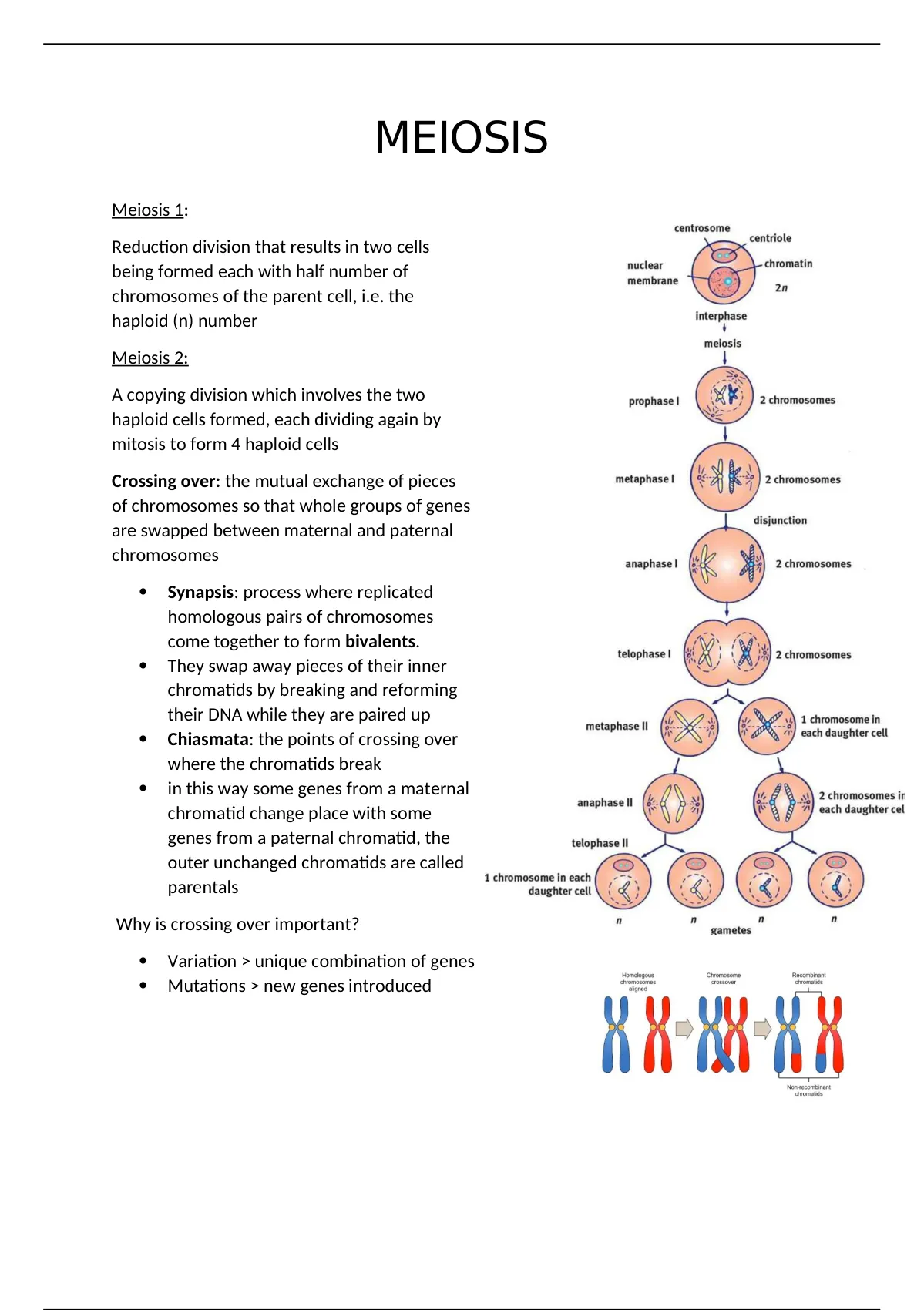
Meiosis II
Similar to mitosis, in that it results in the separation of sister chromatids without a change in ploidy, and is therefore known as equational division
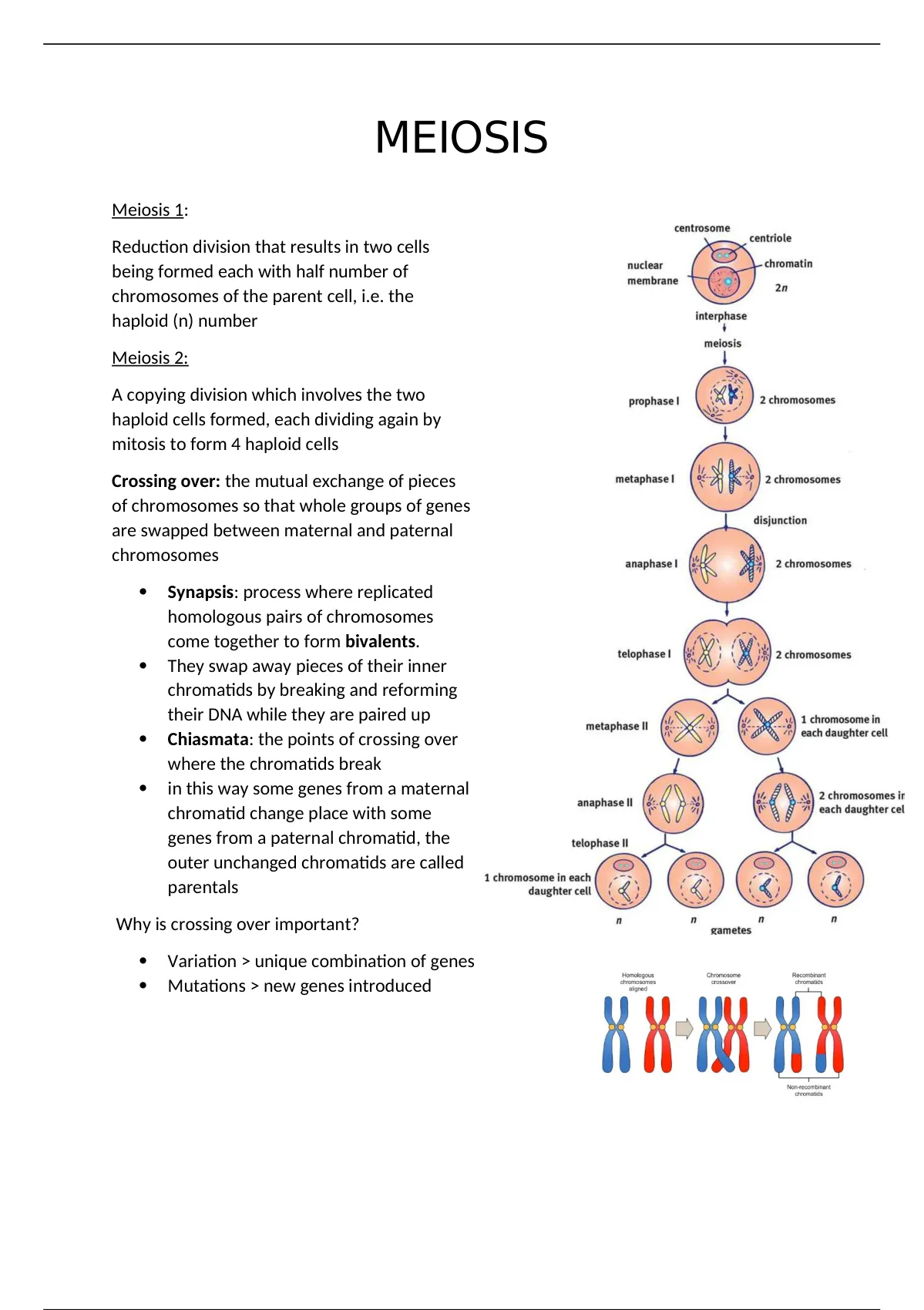
Prophase I
The chromatin condenses into chromosomes, the spindle apparatus forms, and the nucleoli and nuclear membrane disappear; Homologous chromosomes come together and intertwine in a process called synapsis; Each synaptic pair contains four chromatids and is referred to as a tetrad; Homologous chromosomes are held together by a group of proteins called the synaptonemal complex; Chromatids of homologous chromosomes may break at the point of contact, called the chiasma and exchange equivalent pieces of DNA in a process called crossing over
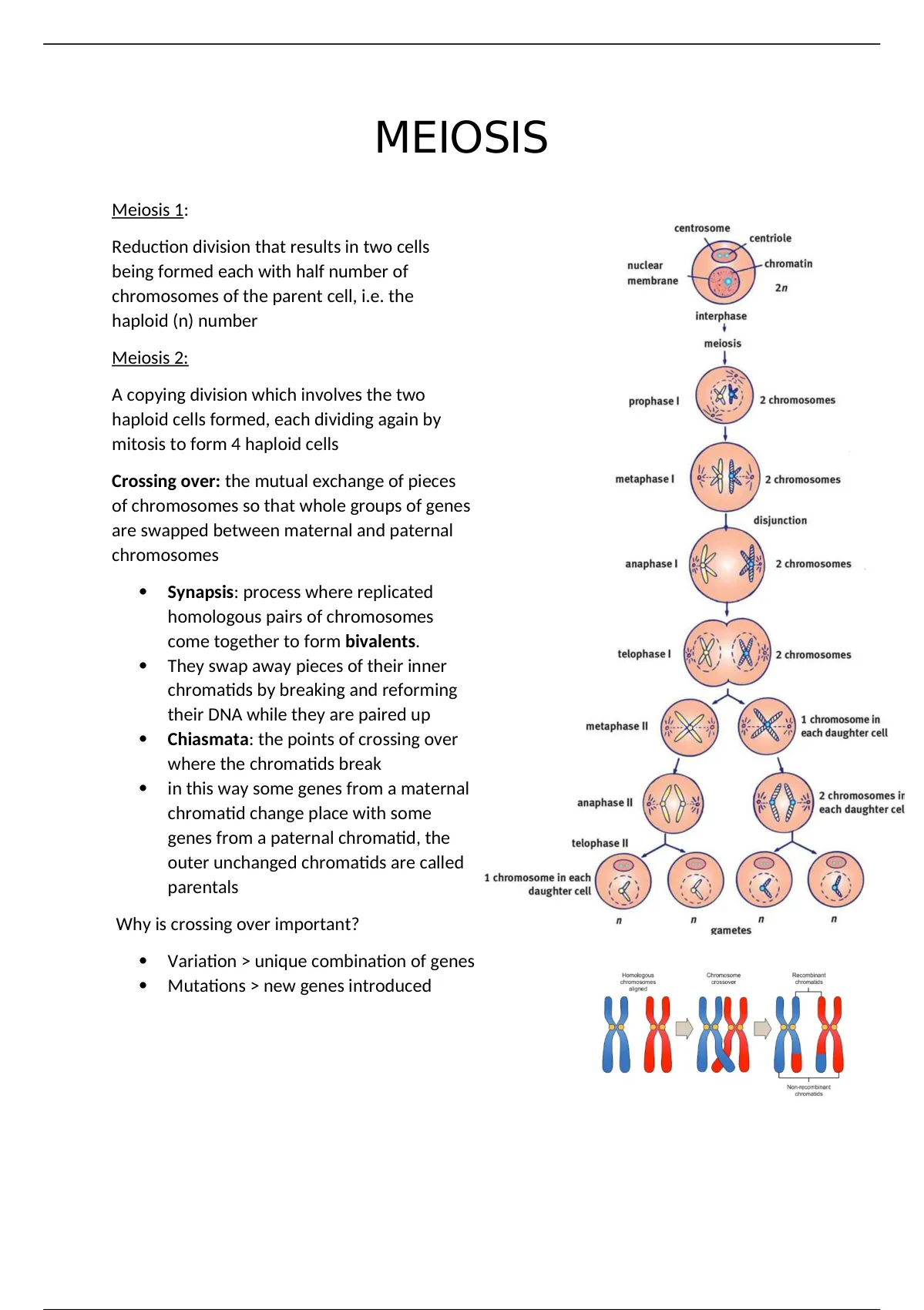
Synapsis
Homologous chromosomes come together and intertwine; Occurs during prophase I
Crossing Over
When chromosomes break at their chiasmata and exchange equivalent pieces of DNA
Linkage
The tendency for genes to be inherited together
Independent Assortment (Mendel’s Second Law)
States that the inheritance of one allele has no effect on the likelihood of inheriting certain alleles for other genes
Metaphase I
Homologous pairs (tetrads) align at the metaphase plate, and each pair attaches to a separate spindle fiber by its kinetochore; Homologous chromosomes are lined up across from each other at the metaphase plate and are held by one spindle fiber
Anaphase I
Homologous pairs separate and are pulled to opposite poles; Disjunction
Disjunction
Each chromosomes of paternal origin separates from its homologue of maternal origin, and either chromosome can end up in either daughter cell; Occurs during anaphase I; Accounts for Mendel’s First Law of Segregation
Segregation
Separating of the two homologous chromosomes; Accounts of Mendel’s First Law